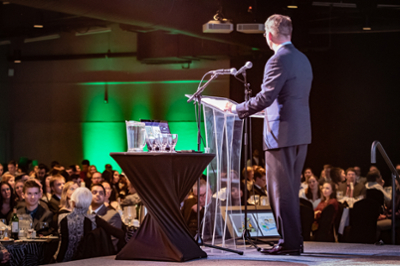About the Gala

Founded in 1976, the C.J. Mackenzie Gala is the college’s flagship event.
Engineering professionals, leading companies and organizations, and USask Engineering alumni join students, faculty and staff from the college to celebrate a distinguished graduate who delivers a keynote address.
The gala has become known within the engineering community as the premier event where engineers gather, connect with students, network, celebrate a distinguished USask Engineering alum and learn from their keynote address.
Tickets are on sale now https://cjm2026.eventbrite.ca
Program & Menu
5:00 PM: Cocktails
6:30 PM: Program
9:30 PM (Approx): Evening ends
The evening's menu will be shared closer to the date of the gala.
For those with food allergies or dietary restrictions, you will be able to select a declare your allergy/dietary restriction during the ticket purchasing process and the chef at Prairieland Park will make a custom meal to accommodate your needs.
Location
Prairieland Park - Hall A
503 Ruth St W, Saskatoon, SK S7K 4E4
Gala history

The College of Engineering’s annual Distinguished Lecture Series was started in 1976 to honour our alumni who have achieved positions of eminence in the profession.
On its 10th anniversary, the event was renamed for Chalmers Jack Mackenzie, the first dean of the College of Engineering, to recognize the contribution he made to the college, the university and the engineering profession.
Each year, discipline departments rotate as the host department, where one of their alumni are selected to be the Distinguished Lecturer.
About C.J. Mackenzie
C.J. Mackenzie was the first Dean of the College of Engineering, University of Saskatchewan, a great Canadian and an eminent engineer. In honour of his contributions to the engineering profession and the college, the Mackenzie dress tartan has been adopted as the college tie of the Saskatoon Engineering Student Society.

The College of Engineering is proud to have been part of the life and career of Dr. Mackenzie. His many achievements in developing the college's engineering resources were a result of his technical excellence and his personal values.
Although his death in 1984 was mourned as a loss, we are thankful for the contributions he made to our college and our country. He remains an integral part of Canadian engineering and science history. His life as a great Canadian and great engineer is a model for all young engineers.
Chalmers Jack Mackenzie was born in 1888 in New Brunswick and graduated from Dalhousie in 1909. He moved west, doing consulting work, and then joined the University of Saskatchewan in 1912 as a sessional lecturer. Following studies at Harvard in 1914-15 leading to a MSc degree, and a distinguished war career in which he was awarded the Military Cross, he was appointed the first Dean of Engineering in 1922, and remained with the college until 1939.
Dr. Mackenzie's zest and style were unique in Canadian academic and engineering circles. During the depression, he designed and oversaw the construction of the Broadway Bridge. His character is reflected in its innovative and unique design.
Dr. Mackenzie's long and varied career involved working with scientists, engineers, administrators, students and even Politicians. In 1939, Dr. Mackenzie left the College of Engineering to accept the position of Acting President of the National Research Council. Following the war, Dr. Mackenzie deferred plans to dissolve the National Research Council by convincing the Government of Canada of its importance in promoting technological advancement in Canada. In 1944 he was appointed President of the National Research Council. In 1948 Dr. Mackenzie spearheaded Canada's nuclear development by serving as President of the Atomic Energy Board.
The science and engineering community awarded Dr. Mackenzie more than 20 medals, awards, and university degrees. He was the first North American to receive the Kelvin Medal for Engineering from Britain in 1953. He received our country's highest honour when he was named Companion of the order of Canada.
